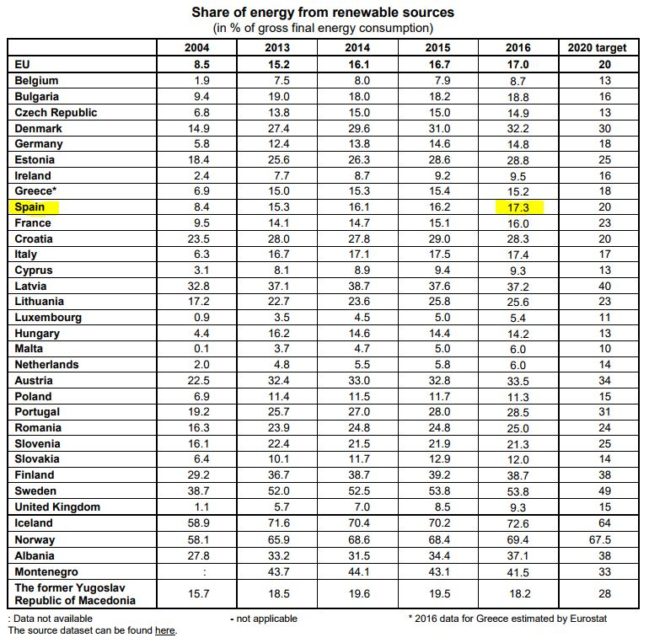-
Phone Number
-
Email Address
Europe is a land of contrasts and of course, if We look at the energy sector, we are not left behind. Even so, In recent years, a series of milestones have been framed important ones that are paying off, some positive and others, although they present rather negative conditions, in Together, they provide an energetic fortress over the Union Europe that until now had not been seen.
In this article we want to show a series of graphs from different recently published reports that highlight the positive energy future of the European Union. (Let us remember that we have already seen the energy perspectives of the renewables worldwide)
Although not all countries follow the same pace and progress required by the EU according to its legislation or the objectives framed for 2020 (Remember a 20% participation of renewable energy sources in gross energy consumption end of the EU) the data together we could frame them as quite positive.
And of course, after seeing the article with the video of what if you live in a city that only uses energy renewables, the path must continue positively.
Content menu:
Last week, the Eurostat office published the data corresponding to 2016 on compliance and evolution of the objectives established for 2020 in the field of renewable energy.

In the EU as a whole , the proportion of renewable energy over total gross energy consumption in 2016 it reached a more than respectable 17% . Even though this value is exactly three points below the target of the community bloc for 2020 (20%). This figure doubles the registered for that 2004, the first year on which there are available data that amounted to 8.5%.
If we look at the more detailed data…

Energy from renewable sources represents for Spain 17.3% of total consumption (We are talking about the year 2016), still below the 20% target set for 2020, which which places it in the group of Member States that have not yet achieved its national goal. I think we will arrive very tight!
New renewable energy generation increased strongly in 2017, with wind, solar and biomass energy surpassing coal for the first time. without counting the hydroelectric potential.

Increased 12% in 2017 to 679 Terawatt hours. Is about incredible progress, considering that only five years, coal generation was more than double that of wind, solar energy and biomass.
Counting on hydroelectric generation we would have. Data comparisons of 2016 – 2017.

The growth of renewable energy has been become even more unequal between the countries of the Union European . Only Germany and the UK contributed to 56% of the growth of renewable energies in the last three years.

There is also a bias in favor of wind power: in 2017 there was a massive 19% increase in wind generation, due to good wind conditions and the great investment in wind power plants. This is good news since the biomass boom is over, but the bad news is that solar energy was responsible for only 14% of the growth of renewable energies between 2014 and 2017.
Electricity consumption grew by 0.7% (23 terawatt hours) in 2017 , marking a third year consecutive increase. With the European economy back in a path of growth, the demand for electricity will also is increasing.

Industrial production increased faster than GDP in the EU, which means that economic growth consumed more energy than normal. The industrial production index of EUROSTAT for November 2017 is 4% higher than for November 2016.
This indicates that Europe's efforts in of efficiency are not enough and, therefore, the policy of efficiency in the EU must be further strengthened .
CO2 emissions in the energy sector remained unchanged in 2017 and increased across the economy as a whole. The low hydroelectric and nuclear generation, together with the increased demand, led to a growing generation of fossils. Thus, despite the large increase in generation wind energy, it is estimated that CO2 emissions from the sector energy remained unchanged at 1019 million tons.

Let's remember the article from Sweden where it approved the law of zero emissions by 2045.
However, the total stationary emissions in the EU emissions trading sectors increased slightly, from 1750 to 1755 million tons, due to stronger industrial production, especially in increased steel production. Along with the increments additions to oil and gas demand not related to the ETS, we estimate that total greenhouse gas emissions EU greenhouse rose by around 1% in 2017.
Western Europe is phasing out coal, but Eastern Europe clings to coal. three others Member States announced the phasing out of the coal in 2017: the Netherlands, Italy and Portugal. join France and the United Kingdom to commit to eliminate progressively coal, while the countries of Europe Easterners cling to coal.

The debate is served in Germany, the largest consumer of coal and lignite from Europe, whose future will be decided in 2019.
If you liked the article, rate it and share!